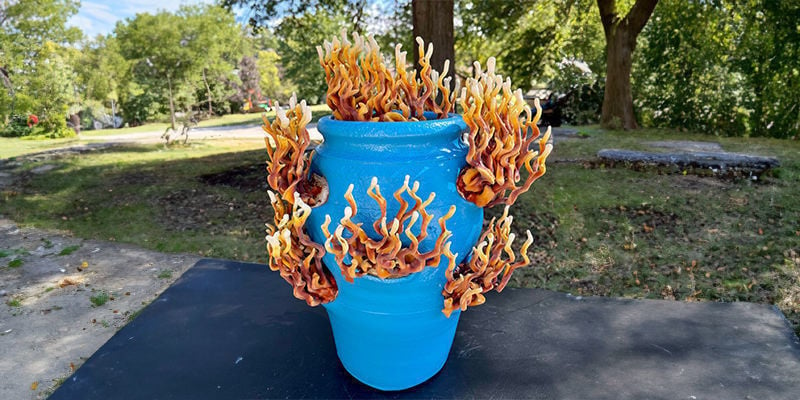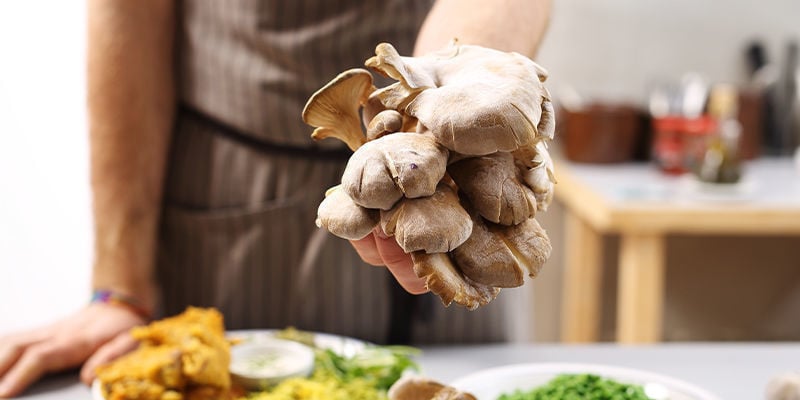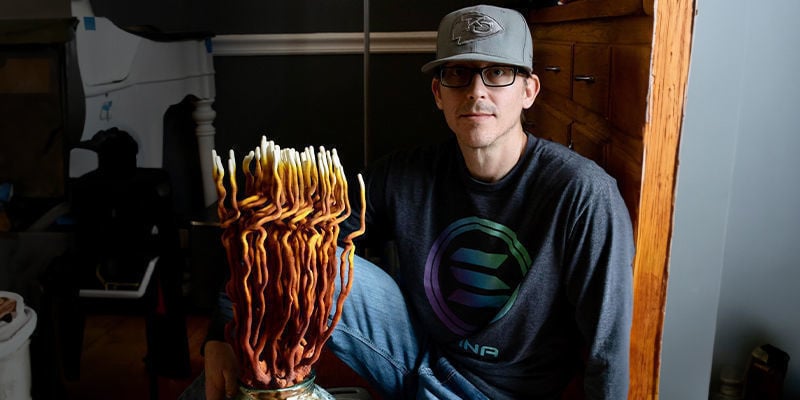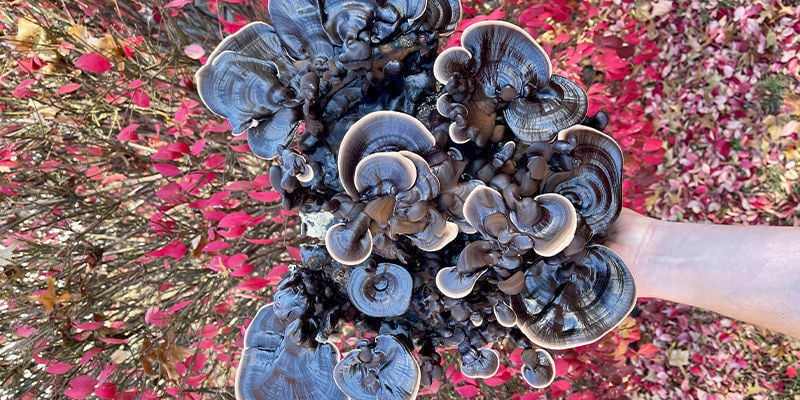
Fungal Flowers: Can Mushrooms Revolutionise The World Of Floristry?
Mushrooms and flowering plants belong to two entirely different kingdoms of life. However, species from each are undeniable beautiful. Humans have grown and displayed flowers in their dwellings for thousands of years. With the advent of fungal floristy, driven by artists such as Josh Roland, could fungi soon join them as decorative counterparts?
Humans have grown and harvested flowers for thousands of years, largely to appreciate their beauty and aroma. The floral industry continues to expand, and figureheads are trying to steer it in a sustainable direction. While mushrooms belong to another kingdom of life, budding fungal florists are attempting to penetrate the world of floristry and show off the unparalleled aesthetics of certain fungal species. Discover the emerging field of fungal floristry below, and join us as we interview Josh Roland, a pioneering cultivator who produces truly dazzling pieces of fungal art.
From flowers to power: How mushrooms are changing the world for the better

Just several years ago, most people related the word “mushroom” to nothing more than the small white button or larger portobello that would occasionally occupy their dinner plate. However, an explosion of books, articles, and documentaries showcasing recent findings in the field of mycology—the study of fungi—has changed the way most people view mushrooms.
Archaically viewed as plants missing certain organs by the Greek philosopher Theophrastos around 300 BCE, some researchers continued to regard mushrooms as plants up until the 1960s. Thanks to breakthroughs in taxonomy, such as genetic sequencing, fungi now exist in their rightful kingdom, distinct from organisms that belong to the plant and animal kingdoms (Fungi Foundation, n.d.).
Just like plants, many types of mushrooms are simply the fruiting bodies of a much larger organism. Known as mycelium, these fungal "roots" grow out into a growing medium such as soil, decaying wood, or even the bodies of insects. Scientists have shown that some mycelium networks fuse with the roots of plants and even act as communication channels between trees. Researchers are only just getting to grips with the many secrets of the fungi kingdom, but their findings are already being tested in a wide range of domains, where they pose promising solutions to serious issues, including pollution and sustainability.
For example, research teams are currently using carbon filaments derived from fungi in supercapacitors that could serve as storage devices in renewable energy systems (Corless, 2024). Certain types of fungi also show the potential to remediate pollution by breaking down petroleum and herbicides and immobilising heavy metals such as lead (“In Cleveland”, n.d.). Moreover, mycomaterials (substances made from mycelium) could replace non-biodegradable materials in product packing. On top of this, fungal biostimulants could provide an alternative to harmful agricultural chemicals when it comes to enhancing crop yields (Sun & Mohamad Hesam Shahrajabian, 2023).
Fungi are certainly poised to revolutionise a multitude of industries in the coming years. While floristry might seem like an unlikely sector for mushrooms to make an impact, a pioneering grower has already entered the space and demonstrated that the future of floristry could very well include fungi.
Shroomshop
Zamnesia's Shroomshop stocks a wide variety of magic truffles, mushroom growing kits, spore prints, and more.
The floral industry is going green: Will mushrooms play a part?

Currently, the global cut flowers market rakes in a staggering $28 billion annually, a figure set to rise to $47 billion by 2030 (“Global Cut Flowers”, 2022). However, this figure becomes somewhat less surprising after assessing the millennia-old relationship between humans and flowers (Huss et al., 2018). While they often provided no physical sustenance, their aesthetic qualities and irresistible aromas have captured humanity’s affinity for beauty since time immemorial.
In the modern age, this penchant for blossoms manifests as a truly massive market, which, much like agricultural operations that grow food, has a considerable environmental impact. The fact that cut flowers aren’t edible means cultivators aren’t held to the same regulations as food growers; growers are able to use untested pesticides or those banned in edible agriculture. The industry also has sizable water and carbon footprints.
With these issues in mind, voices in the floral industry are attempting to drive change by vouching for the utilisation of renewable energy and recycling. Interestingly, mushrooms are one of the most sustainable options when it comes to food production. They require less water (Mushroom Sustainability Research | Mushroom Council, n.d.), less space, and less energy. Instead of expensive growing media, many mushrooms will thrive when fed “waste” materials such as wood chips and sawdust, spent beer grains and coffee grounds, manure, and cardboard. It just so happens that some mushrooms are so aesthetically stunning that they also double up as an alternative to traditional flowers.
Fungal floristry: An interview with pioneering artist Josh Roland

To get a deeper insight into the emerging industry of fungal floristry, we interviewed a pioneer in the field, Josh Roland. As one of the best mushroom artists on the planet, Josh creates stunning fungal flowers using the likes of reishi and cordyceps. Find out how Josh got started, where he thinks the industry of fungal floristry is headed, and how you can get started growing your own mushroom flowers in the interview below.
What drew you to mushrooms and mycology in the first place? And how did you transition into fungal floristry?
I spent many years working in a corporate job that made me miserable and was deeply unfulfilling. This led to a low point in my life, and I began looking for something besides antidepressants to provide some mental relief. I started finding a bunch of information that talked about the benefits of psilocybin mushrooms, and I gave them a try. This led to a massive transformation that changed the course of my life. I started researching and learning as much as I could, and in 2022, I decided to go all in and start a gourmet mushroom business. While growing and experimenting with as many mushroom species as possible I stumbled across reishi (Ganoderma lucidum). After the first successful grow, I noticed that the mushrooms were growing differently depending on where they were in relation to the light source. From there, I became obsessed and began experimenting to see how much I could manipulate the mushrooms into different shapes under the right conditions. After the first run of purposefully manipulating the shapes using high CO₂ and light, I abandoned the gourmet mushrooms and decided to focus full-time on reishi mushroom art.
Is there a history of mushroom cultivation geared towards fungal floristry? Or did the idea originate with yourself?
In China and other places, reishi mushroom art has been around for a long time, but it's different from what I do, and I wasn’t aware of it when I first started. I can’t say I’m the first, but I can say I am one of the best at artistic reishi cultivation. It was basically an observation turned into an obsession.
What are some of the best species when it comes to making a fungal bouquet?
I’m still experimenting with as many Ganoderma species as possible, but a few of my favourites to work with are G. multipileum (antler reishi), G. sinense (black reishi), G. sessile, and G. lucidum (red reishi).
Past their aesthetic qualities, do fungal flowers have any functional use? How can growers or consumers harvest and use them?
Reishi is a highly medicinal mushroom that has been used for thousands of years in Eastern medicine. It is not an edible mushroom, but it can be boiled into a tea or processed into powerful mushroom extracts. Reishi is a fairly easy species to grow as it will grow completely in a sealed grow bag; however, to grow more complex shapes is significantly more difficult.
What’s your usual client base for fungal “flowers”?
The mushroom-loving community is wide and diverse; I’ve sold pieces at farmers' markets, boutiques, art fairs, and online. Since it's relatively new, most people don’t even know such a thing exists, so I spend a lot of time trying to bring awareness. I also sell dried reishi to other mushroom companies who then process them into extracts.
Do you see a future for fungal floristry and its increasing use in the floristry industry?
Absolutely, that’s my plan. I have no doubt this will be a rapidly growing industry once people are exposed to the natural beauty of these mushrooms. Flowers are beautiful but they eventually die and get tossed out; these are pieces of forever art that you can’t kill—and they make a perfect gift.
Do you have any beginner tips for those looking to dip their toes into the world of fungal floristry?
If you want to get started growing mushrooms, I suggest starting with grow kits. They enable you to observe and learn without having to have a bunch of equipment to get started. YouTube is a great source to find basic information and tips and tricks.
Are fungi the flowers of the future?

Fungal flowers are undeniably stunning. Not only do they look great as ornamental pieces, but they last much longer than cut flowers. On top of this, both home growers and consumers can harvest edible species and use them to make tea and other preparations. Compared to flowers, mushrooms are easier to grow using sustainable methods, with most species thriving on materials gathered from economic waste streams. Fungal floristry certainly remains a niche artistic endeavour for now, but after speaking to an expert, we’re convinced that they’ll work their way into the floral industry, perhaps side-by-side with flowers, or in entirely fungal bouquets of their own.
Bio

Josh Roland: Artist, cultivation specialist, and entrepreneur
Company: The Fungi Florist
Bio: My mission is to change the negative perception many people have of mushrooms through my art, to expand what people think is possible, and from that point, begin the conversation of the powerful medicinal benefits and profound life-changing potential of fungi.
Where to find Josh: Instagram, Facebook & Etsy
- (n.d.). (n.d.). Fauna, Flora, Funga | Fungi Foundation - https://www.ffungi.org
- (n.d.). (n.d.). Mushroom Sustainability Research | Mushroom Council - https://www.mushroomcouncil.org
- (n.d.). (n.d.). In Cleveland, mushrooms digest entire houses: How fungi can be used to clean up pollution - https://www.bbc.com
- Corless, & V. (2024, April 11). Mushrooms could be the next big thing in energy storage - Advanced Science News - https://www.advancedsciencenews.com
- Florists’ Review. (2022, November 27). Global Cut Flowers Market to Hit Sales of $47.9 Billion by 2030 | Florists' Review - https://floristsreview.com
- fungi_florist. (n.d.). Instagram - https://www.instagram.com
- Huss, Ephrat, Bar Yosef, Kfir, Zaccai, & Michele. (2018/3). Humans’ Relationship to Flowers as an Example of the Multiple Components of Embodied Aesthetics - https://www.mdpi.com
- Sun, Wenli, Shahrajabian, & Mohamad Hesam. (2023/1). The Application of Arbuscular Mycorrhizal Fungi as Microbial Biostimulant, Sustainable Approaches in Modern Agriculture - https://www.mdpi.com
- The Fungi Florist . (n.d.). Facebook - https://www.facebook.com
- THEFUNGIFLORIST. (n.d.). THEFUNGIFLORIST - https://www.etsy.com
-
 4 min
3 July 2023
Discover Top 10 Mushrooms For Your Health
With so many varieties of mushrooms available, there's plenty that our funghi friends offer in terms of potential health and well-being benefits for users. What's more is that these mushroom...
4 min
3 July 2023
Discover Top 10 Mushrooms For Your Health
With so many varieties of mushrooms available, there's plenty that our funghi friends offer in terms of potential health and well-being benefits for users. What's more is that these mushroom...
-
 3 min
17 August 2020
5 Surprising Benefits of Magic Mushrooms
There are so many factors to consider when taking magic mushrooms, and it can be daunting overall. However, there are many benefits to taking this psilocybin-packed hallucinogen. Continue reading...
3 min
17 August 2020
5 Surprising Benefits of Magic Mushrooms
There are so many factors to consider when taking magic mushrooms, and it can be daunting overall. However, there are many benefits to taking this psilocybin-packed hallucinogen. Continue reading...
-
 3 min
29 October 2019
Magic Mushrooms Are The Safest Drug
A psilocybin trip can be fun and enlightening, but just how safe is it to trip on magic mushrooms? In this article, we’ll take a deep dive into the world of magic mushrooms, and show you just how...
3 min
29 October 2019
Magic Mushrooms Are The Safest Drug
A psilocybin trip can be fun and enlightening, but just how safe is it to trip on magic mushrooms? In this article, we’ll take a deep dive into the world of magic mushrooms, and show you just how...
-
 3 min
30 May 2016
Magic Mushrooms: The Real Philosopher's Stones?
There is a lot of evidence out there to suggest that the philosopher’s stone is real, it's just not what most people have come to expect.
3 min
30 May 2016
Magic Mushrooms: The Real Philosopher's Stones?
There is a lot of evidence out there to suggest that the philosopher’s stone is real, it's just not what most people have come to expect.













 United States
United States











